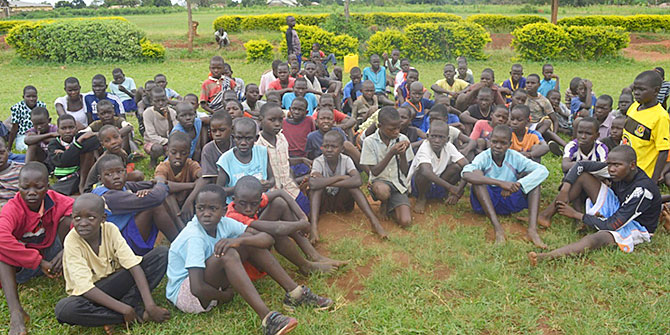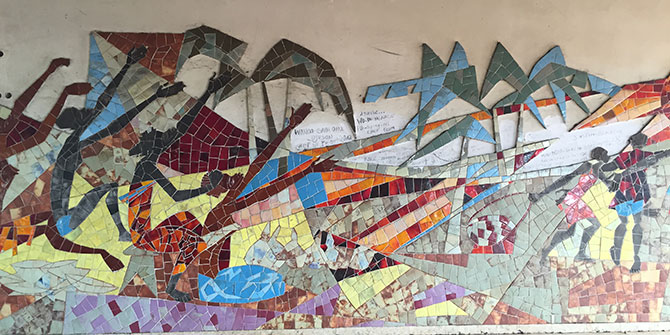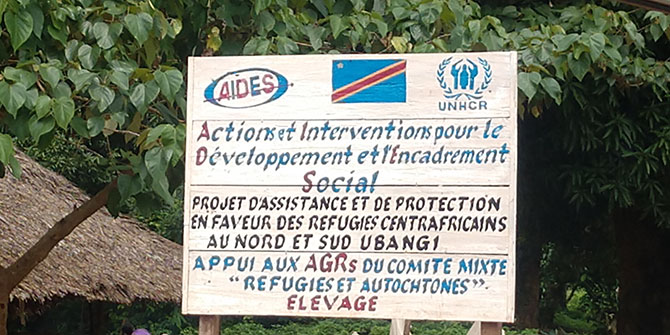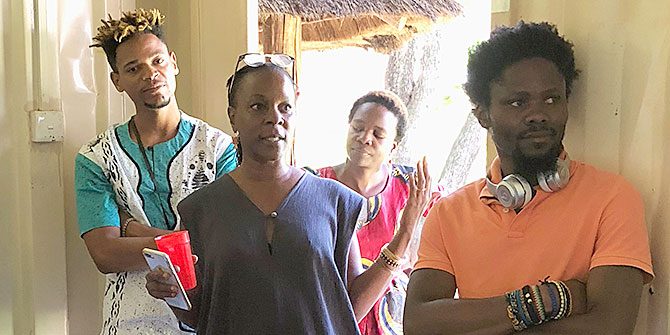Recent research suggests that the lives of women who have returned from extended periods with the Lord’s Resistance Army greatly vary. These differences often depend on what kind of authority they commanded with the LRA and the status of their husband, which profoundly affect their experiences of return, with old hierarchies surviving into peace time.
This post is part of the Africa at LSE blog series Displacement and Return.
Much has been written about life with the Lord’s Resistance Army (LRA) and the difficulties facing young men and women who spent extended amounts of time with the rebel group. This literature often discusses the challenges facing returnees, such as to imply that they are pervasive among everyone who returns, thereby downplaying the variations between the current lives of returnees.
Our research suggests these variations are especially prevalent among women who, when living with the LRA, often performed different roles. Women who were viewed (and viewed themselves) as married to senior commanders, and became senior wives within a commander’s household, have tended to manage much better on return than those who did not hold such positions.
Hierarchies of life with the LRA
In the late 1990s to early 2000s, the LRA established numerous military bases in South Sudan. In the region they had a relatively stable life where they cultivated food and built schools and health care centres. Through these bases, the head of the LRA, Joseph Kony, attempted to revive a kind of Acholi way of life, shaped by his own views about morality and the spirit world. To achieve his vision, girls and women were abducted from villages and internal displacement camps and given to LRA commanders as ‘wives’. There was a clear expectation that all wives should bear as many children as possible – to populate a new Acholi society.
Top commanders were made heads of households; those below the rank of a major, their wives, maids (ting ting), children and young fighters became part of their ‘family’. Without exception, the top commanders had numerous wives. Joseph Kony, for example, had more than 100 wives, the late Vincent Otti 40 wives, and Dominic Ongwen is reported to have had around 30 wives. The more junior the rank, the fewer the wives a man was ‘given’.
To assert control over his ‘family’, commanders often appointed their first wife as the most ‘senior’, with subsequent wives being referred to as ‘juniors’. This created competition between women as they jostled to gain the attention and support of their allocated husband. Although women invariably described their initial enforced sexual intercourse as terrifying and traumatic, over time they came to view sex and physical closeness as a means to survival. Many of them said they wanted to be ‘more loved’, and have ‘more time for sexual intimacy’.
Senior wives clearly exploited more junior wives and developed strategies to maintain authority within the ‘family’. To ensure that they had more time with their husbands, they warned those junior not to get too close to their ‘husbands’, and they often made false allegations about them behaving inappropriately. One junior wife, for example, reflected on her time with the LRA:
‘One time she accused me in front of our husband of not cooking well. He didn’t listen to me, but ordered her to beat me until I learnt how to cook. She took advantage of that and beat me every day. The other women knew that she was mistreating me for no reason, but they couldn’t open up.’
Senior wives not only forced junior wives to cook for them, serve them and take care of their children, but they also ensured that they took the best items brought by their husbands. They cooked ‘good’ food (such as meat, fish and chicken) to present to their husbands. Meanwhile, the junior wives struggled to get food that would attract their husband’s attention.
One young woman described the situation in the following way:
‘One day our husband returned from Juba and brought a lot of items: cooking oil, clothes, washing soap and meat. He gave them to the most senior wife … She divided the meat with a senior co-wife … When I asked her: “why did you not give us [the two junior wives] anything?”, she replied: “this meat belongs to the seniors and the husband.” I feared to report her to avoid being punished later. We were also supposed to receive two bars of washing soap, but instead she gave us half a bar each.’
The competition, jealousy, discrimination, fighting and even outright hatred between wives and ting ting sometimes escalated into accusations – false or otherwise – of trying to escape, or of witchcraft. We have collected shocking stories, including of the collective slaughter of alleged witches after they admitted ‘guilt’ under torture.
Replicating LRA hierarchies during peace
Unsurprisingly, these tensions and hierarchies were evident in the reception centres when some of these women returned. Kony’s senior wives, for example, initially insisted on eating, sleeping and bathing together. They shared items like washing soap and clothes and carried on giving orders to young girls and boys to fetch water for them, and to wash the clothes of their children.
Although some senior wives were returned to their maternal homes, the majority did not stay long. Facing intense rejection, they regrouped and moved to towns and trading centres where they could live close to each other, help access training programmes provided by NGOs and develop their own ‘community based organisations’ and village saving and loans associations.
Talking to these women fifteen year later, we have found that almost all these organisations are headed by the former senior wives of top LRA commanders. Unsurprisingly, women are unhappy with the on-going authority of senior wives. For example, one young woman suggested a community based organisation’s leadership should be time-limited, and described to us the leader’s response:
‘“You like talking too much, you are jealous of our work, we shall continue working with those who will corporate with us.” Other women got scared of their utterances and shied away … From that time, I was isolated and the name of my daughter was removed from the scholarship programme.’
In a similar vein, a child to one of Kony’s junior wives commented:
‘When I think about my mother and her situation, and compare her to one of [name of a senior wife to Kony] and how she is living well, I ask [myself]: why not my mother?’
She is alluding to the fact that one of Kony’s senior wives now has her own brick built house, sends her children to good schools, accesses food and medical services and is able to take care of her children in a way that others cannot.
The senior wives of the top commanders have maintained their social connections with one another in urban centres. By sharing information and working together, they are able to secure scholarships for their children, access training opportunities and financial support from a variety of NGOs.
Junior wives, by contrast, are predominantly excluded from these networks, especially those living in rural areas, unless they are prepared to accept a subservient relationship with their former seniors. Many are appalled by the prospect, highlighting the cruelty that they experienced at the whim of senior wives in the bush, and resist efforts by them to reassert control.
They are also well aware that the very skills that enabled some women to assert their authority and even prosper in the bush have enabled those same women to re-establish and consolidate their positions back home. Unsurprisingly, abducted and raped women excluded from the perceived benefits accumulated by the former senior wives, including access to NGOs and researchers, is a matter of considerable resentment.
Photo credit: youngrobv, Flickr, creative commons.






Are the hierarchies of the Lord’s Resistance Army able to maintain their structure and influence during times of peace?